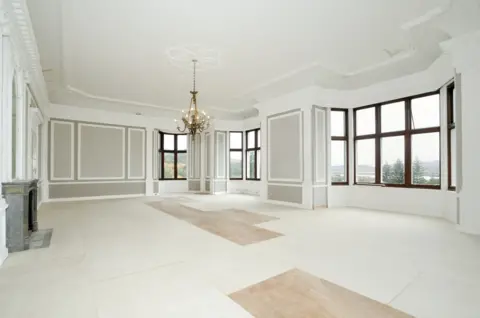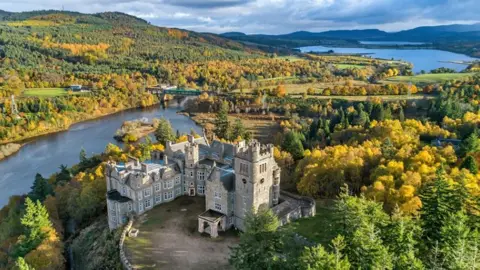'Haunted Castle of Spite' back on the market
 Strutt and Parker
Strutt and Parker Strutt and Parker
Strutt and Parker- Historic country house Carbisdale Castle is back up for sale for offers over £1.2m.
- The early 20th Century property in Sutherland was built for a duchess as part of a settlement in a bitter feud with her late husband's family.
- It is the third time in six years the castle has been offered for sale, and follows former plans to turn it into a hotel.
- Carbisdale - which for about 60 years was run as a youth hostel - is said to be haunted by a ghost called Betty.
A country house built for a duchess embroiled in a feud with her in-laws and said to be haunted by a ghost called Betty is back on sale.
It is the third time in six years Carbisdale Castle, near Ardgay in Sutherland, has been on the market.
The 19-bedroom, B-listed early 20th Century cliff-top property is available for offers over £1.2m.
Over the years, it has been a war-time sanctuary for members of the Norwegian royal family and a youth hostel.
There had been recent plans to turn it into a hotel.
Carbisdale became known as the Castle of Spite because of its original resident's bitter dispute with her husband's family.
Mary Caroline, the Duchess of Sutherland, was the second wife of George Sutherland-Leveson-Gower, the third Duke of Sutherland.
The duchess, the widow of an army officer who had been killed in a hunting accident, was not well-liked by the duke's family.
When the duke later died, the duchess' inheritance was contested by her stepson. She was even jailed for six weeks in London's Holloway Prison after being accused of destroying documents linked to the will.
Clock faces
The dispute was eventually settled, with the Duke of Sutherland's family agreeing to build the duchess a new home - provided it was outside the boundaries of the duke's Sutherland Estate.
The duchess selected a hillside plot close to - and visible from - the estate.
Its clock tower only has three faces, with the side facing Sutherland Estate blank because the duchess did not want to give her former in-laws the time of day.
 Strutt and Parker
Strutt and ParkerDuring World War Two, when Carbisdale was under different ownership, King Haakon VII of Norway and Crown Prince Olav were given sanctuary at the castle during the Nazi occupation of Norway.
An agreement was also signed at Carbisdale that required Russian troops, who had captured Norwegian villages while fighting German soldiers, to withdraw from Norway at the end of the war.
For about 60 years from 1945, the property was run as a youth hostel.
Carbisdale's ghost Betty was said to be well-known among people who stayed at the hostel.
The Scottish Youth Hostels Association even dubbed one of the top-floor bedrooms as the "spook room" because of claims it was haunted.
Betty was said to appear dressed in white in various parts of the property.
'Blank canvas'
Robert McCulloch, head of estates and farms in Scotland at selling agents Strutt and Parker, said Carbisdale had a rich and notable history.
He said: "The property today can be viewed as a ‘blank canvas’ of almost 42,000 sq ft of internal accommodation enabling a buyer to take the property in whatever direction they prefer.
"That could be as a private home, a commercial venture - hotel or holiday apartments - or a mixture of both, subject to the appropriate consents."
Mr McCulloch said its striking architecture and dramatic location was likely to attract global interest.
